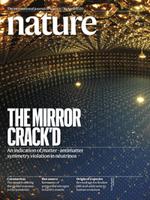Now retired engineer Mircea Cadabeschi has been instrumental over many years in helping design and build T2K detectors in the UofT physics workshop. Former UofT research associate Dr. Mark Hartz, now a staff scientist at the TRIUMF laboratory, coordinated the data analysis and paper preparation and is the corresponding author.
T2K measures the oscillation of beams of accelerator produced muon-neutrinos and muon-antineutrinos to electron-neutrinos and electron anti-neutrinos, respectively, after a 295km flight path across Japan to the Super-K detector. Any difference in the oscillatory behaviour of these matter and antimatter beams gives a measure of the CP violation phase in the mixing matrix connecting the 3 neutrino flavour states (electron-, muon- and tau-) to their mass eigenstates. The phase can take a value from -180º to 180º, with 0º and 180º being CP conserving. T2K has disfavored almost half of the possible values at the 99.7% (3σ) confidence level, and CP conservation is disfavored at 95% confidence level, indicating that CP symmetry may well be violated in neutrino oscillations.
CP violation is one of the necessary conditions in the early universe proposed by Andrei Sakharov in 1967 to explain the profound puzzle why our present universe is made of matter only. The small CP violation already well-measured in the quark sector of the Standard Model of particle physics is insufficient to support this explanation, but perhaps CP violation in the lepton (neutrino) sector will be much larger. Further measurements with the recently approved Hyper-K program in Japan, which involves upgraded beam power, new detectors near the neutrino production target and a gigantic new detector at the 295km site, and the future DUNE program at Fermilab should definitively answer this question.
Links:

